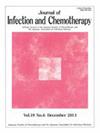Teicoplanin 24-h loading dose regimen using a decision tree model to target serum trough concentration of 15–30 μg/mL: A retrospective study
IF 1.9
4区 医学
Q3 INFECTIOUS DISEASES
引用次数: 0
Abstract
Introduction
Teicoplanin (TEIC) is typically administered as a loading dose over 36–48 h. Achieving an effective concentration quickly is expected to treat severe infections, such as sepsis and methicillin-resistant Staphylococcus aureus infections. We aimed to identify the TEIC loading dose to be completed within 24 h, targeting the concentration of 15–30 μg/mL and factors affecting the loading dose by utilizing the decision tree (DT) model.
Methods
Patients treated with TEIC between January 2017 and December 2022 who met the 24-h loading dose regimen were enrolled. A LD22.5 (corrected TEIC loading dose targeting concentration of 22.5 μg/mL) was determined, factors affecting the concentration were extracted, and a DT model was constructed. The validity of the DT was assessed using the coefficient of determination (R2) in the DT and population pharmacokinetics (PopPK) models for LD22.5.
Result
A total of 149 patients were divided into training (n = 104, 70 %) and test groups (n = 45, 30 %). We indicated an average of 14.5 mg/kg for LD22.5 and extracted four factors (estimated glomerular filtration rate, age, albumin, and C-reactive protein) from the DT model. The R2 values were 0.724, 0.695, 0.681, and 0.653 for the DT models (training and test groups) and two PopPK models, respectively.
Conclusion
We established a 24-h loading dose regimen targeting the TEIC concentration of 15–30 μg/mL and identified four factors affecting the loading dose by using DT. By following the indicated DT algorithm flowchat, optimal decisions regarding the loading dose could be made for TEIC therapy.
使用决策树模型确定血清谷浓度为 15-30 μg/mL 的替考拉宁 24 小时负荷剂量方案:一项回顾性研究。
简介快速达到有效浓度有望治疗严重感染,如败血症和耐甲氧西林金黄色葡萄球菌感染。我们旨在利用决策树(DT)模型确定24小时内完成的TEIC负荷剂量,目标浓度为15-30 μg/mL,以及影响负荷剂量的因素:2017年1月至2022年12月期间接受TEIC治疗且符合24小时负荷剂量方案的患者被纳入研究。确定了 LD22.5(校正 TEIC 负荷剂量目标浓度为 22.5 μg/mL),提取了影响浓度的因素,并构建了 DT 模型。使用 LD22.5 的 DT 和群体药代动力学(PopPK)模型的决定系数(R2)评估了 DT 的有效性:共有 149 名患者被分为训练组(104 人,占 70%)和测试组(45 人,占 30%)。我们将 LD22.5 的平均剂量定为 14.5 mg/kg,并从 DT 模型中提取了四个因子(估计肾小球滤过率、年龄、白蛋白和 C 反应蛋白)。DT模型(训练组和测试组)和两个PopPK模型的R2值分别为0.724、0.695、0.681和0.653:我们建立了以 TEIC 浓度为 15-30 μg/mL 为目标的 24 小时负荷剂量方案,并利用 DT 确定了影响负荷剂量的四个因素。按照指定的 DT 算法流程,可以为 TEIC 治疗做出有关负荷剂量的最佳决策。
本文章由计算机程序翻译,如有差异,请以英文原文为准。
求助全文
约1分钟内获得全文
求助全文
来源期刊

Journal of Infection and Chemotherapy
INFECTIOUS DISEASES-PHARMACOLOGY & PHARMACY
CiteScore
4.10
自引率
4.50%
发文量
303
审稿时长
47 days
期刊介绍:
The Journal of Infection and Chemotherapy (JIC) — official journal of the Japanese Society of Chemotherapy and The Japanese Association for Infectious Diseases — welcomes original papers, laboratory or clinical, as well as case reports, notes, committee reports, surveillance and guidelines from all parts of the world on all aspects of chemotherapy, covering the pathogenesis, diagnosis, treatment, and control of infection, including treatment with anticancer drugs. Experimental studies on animal models and pharmacokinetics, and reports on epidemiology and clinical trials are particularly welcome.
 求助内容:
求助内容: 应助结果提醒方式:
应助结果提醒方式:


